Dating Your Vintage Fender Guitar
By Bobby Brooks
Years ago I examined a childhood friend's Fender Telecaster guitar, not knowing what I was doing; however, today I will try to
help you date your vintage Fender guitar. I didn't know enough back then, I didn't know that Fender guitars were build on an
assembly line, by more than one person, although sometimes at the same time, but often over weeks or a month's time.
A craftsperson could be working on the neck at the same time that someone else was working on the electronics; because different
Luthiers on the assembly line were working on one component of the guitar's construction, and only building that one type of
component, they achieved perfection over time. And then the part would be put in a bin to be used later in the final build.
A guitar could be constructed of a body made last week and a neck made last month or months prior; however, they were most likely
constructed around the same time because they were pushing out new guitars daily. But they all started out life, theoretically
speaking, as parts guitars.
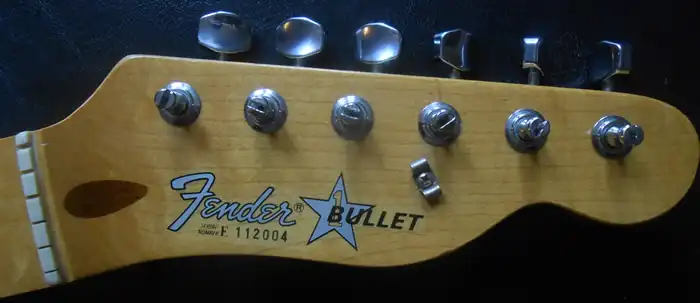
The serial number on the headstock only gives you a clue about the decade in which the guitar was produced, even the numbers are useless in telling you
the year in which the guitar was produced, only the E prefix gives you a clue telling you it was produced in the 1980s, the rest of the numbers were slapped on
without regard to the rest of the serial numbers used in the plant; they were simply using up "old" stock before the plant closed.
And when I examined my friend's guitar, all those years ago, I thought the neck and body didn't match together as I thought they
should, not knowing the guitar could have been put on the showroom floor that way! And the only true way to examine the guitar's
"age" was to examine each part individually!
With Fender's instrument production in the United States, the date of production was either stamped or penciled on various
components.
The production years were stamped or penciled on the end of the neck heel of most guitars and basses, although between the years
1973 to 1981 this wasn't consistently done. But bear in mind this is the year the neck was finished, and not necessarily the
entire instrument. The date of the neck production and the date of the completion of the guitar can differentiate by months.
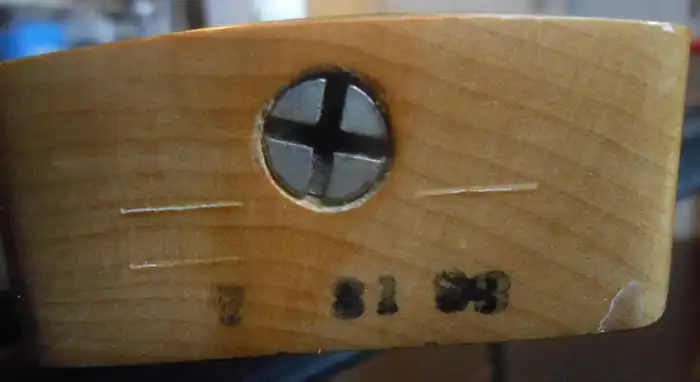
Even the date stamped on the heel of the guitar neck wasn't very reliable if the "ink" smeared, such in this case where my eyes
see an upside down 2, a smeared 81, and a smeared 83; perhaps the body or potentiometers will give a better clue to the age of
the guitar.
Most vintage Fender instrument models didn't change much from year to year, if at all. While there have been periods of major
changes, like during the transition between Leo's operation and when Fender was purchased by CBS, overall changes didn't occur
from year to year.
The serial numbers on Fender instruments have been put in various locations such as the front or back of the headstock, the top
of the neck plate, the bridge plate, the vibrato, and the neck where the neck meets the body.
Nonetheless, dating your vintage Fender guitar by serial number isn't a precise science because the serial numbers overlap by a
few years, and even cover years when the guitar wasn't produced; such as the U.S. made Bullet series where a serial number may
represent the years 1980 to 1981, but the guitars weren't even produced until 1981.

Now we're getting somewhere, at least the stamp in the guitar's neck cavity is clear and showing the 6th month of 82'. The FRR
40 matches the stickers placed inside the pickup cavities (not shown).
Serial Numbers
Up to 6,000
Up to 10,000
10,000s
10,000s to 20,000s
20,000s to 30,000s
30,000s to 40,000s
40,000s to 50,000s
50,000s to 70,000s
60,000s to 90,000s
80,000s to 90,000s
90,000s up to L10,000s
L10,000s up to L20,000s
L20,000s up to L50,000s
Production Dates
1950 to 1954
1954 to 1956
1955 to 1956
1957
1958
1959
1960
1961
1962
1963;
1963
1963
1964
When Fender was purchased by CBS in the first month of 1965 the serial numbering didn't immediately change due to the factory
tooling and number schemes remaining the same.
Serial Numbers
L50,000s up to L90,000s
100,000s
100,000s to 200,000s
200,000s
200,000s to 300,000s
300,000s
300,000s to 500,000s
400,000s to 500,000s
500,000s to 700,000s
76 + 5 digits
S6 + 5 digits
S7 + 5 digits
S7 + 5 digits
S8 + 5 digits
S8 + 5 digits
S9 + 5 digits
S9 + 5 digits
S9 + 5 digits
E0 + 5 digits
E0 + 5 digits
E1 + 5 digits
S9 + 5 digits
E0 + 5 digits
E1 + 5 digits
EI + 5 digits
E2 + 5 digits
E3 + 5 digits
Production Dates
1965
1965
1966 to 1967
1968
1969 to 1970
1971 to 1972
1973
1974 to 1975
1976
1976
1976
1976
1977
1977
1978
1978
1979
1979
1979
1980
1980
1980
1981
1981
1981
1982
1982
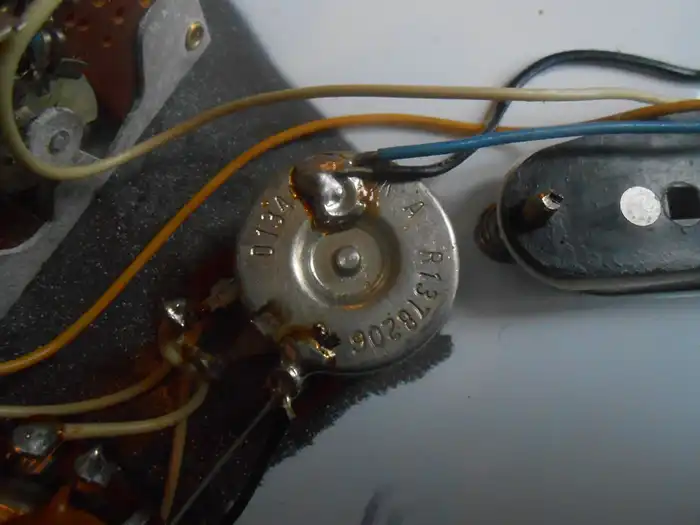
The volume potentiometer shows R1378206 which indicates the 6th week of 1982, so now all the clues are adding up to the production
year being sometime in 1982; and the totally of evidence shows that all the parts are original.
Dating Your Vintage Fender Guitar with Potentiometers
Dating vintage guitars can be frustrating, because the dates don't often match up from the neck stamp, to the body stamp, and to
the potentiometer stamps. The potentiometers will be stamped showing the week and year they were produced by the Chicago
Telephone Supply Company who produced them.
The potentiometers were often stamped on the top, and then covered with solder when they were soldered in place! And they were
stamped on the sides, as well, making it easier to read the codes.
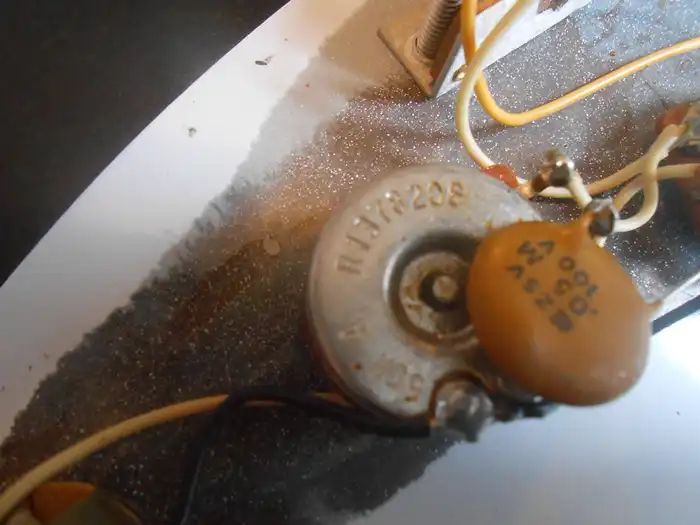
The final clue, the tone potentiometer showing the code R1378208 indicating the pot was made in the 8th week of 1982; solidifying
that this instrument was indeed produced and marketed in 1982.
A potentiometer code which reads 1428214 was stamped in the Chicago (CTS) Factory the 14th week in 1982.
If the dates of your guitar are off by a year or more it usually means the body and neck didn't come together and one or more
parts were replaced. Often parts on older guitars wear out and are replaced over time. And if all the parts are close to date,
you know you have an all original instrument; usually!
Add Comment
Insert Bullet List
Please enter at least one item.
Item:
Item:
Item:
Item:
Item:
Insert Numeric List
Please enter at least one item.
Item:
Item:
Item:
Item:
Item:
Insert Link
Please enter the link of the website
Optionally you can add display text
Insert Email
Please enter the email address
Optionally add any display text
Insert Image
Please enter the link of the image
Insert YouTube Video
Please enter the link of the video
Image Upload
Privacy Policy
This policy contains information about your privacy. By posting, you are declaring that you understand this policy:
- Your name, rating, website address, town, country, state and comment will be publicly displayed if entered.
- Aside from the data entered into these form fields, other stored data about your comment will include:
- Your IP address (not displayed)
- The time/date of your submission (displayed)
- Your email address will not be shared. It is collected for only two reasons:
- Administrative purposes, should a need to contact you arise.
- To inform you of new comments, should you subscribe to receive notifications.
- A cookie may be set on your computer. This is used to remember your inputs. It will expire by itself.
This policy is subject to change at any time and without notice.
Terms and Conditions
These terms and conditions contain rules about posting comments. By submitting a comment, you are declaring that you agree with these rules:
- Although the administrator will attempt to moderate comments, it is impossible for every comment to have been moderated at any given time.
- You acknowledge that all comments express the views and opinions of the original author and not those of the administrator.
- You agree not to post any material which is knowingly false, obscene, hateful, threatening, harassing or invasive of a person's privacy.
- The administrator has the right to edit, move or remove any comment for any reason and without notice.
Failure to comply with these rules may result in being banned from submitting further comments.
These terms and conditions are subject to change at any time and without notice.
{"commentics_url":"\/\/skoukor.com\/cmt\/","page_id":399,"enabled_country":true,"country_id":0,"enabled_state":true,"state_id":0,"enabled_upload":true,"maximum_upload_amount":3,"maximum_upload_size":5,"maximum_upload_total":5,"captcha":false,"captcha_url":"","cmtx_wait_for_comment":"cmtx_wait_for_comment","lang_error_file_num":"A maximum of %d files are allowed to be uploaded","lang_error_file_size":"Please upload files no bigger than %.1f MB in size","lang_error_file_total":"The total size of all files must be less than %.1f MB","lang_error_file_type":"Only image file types are allowed to be uploaded","lang_text_loading":"Loading ..","lang_placeholder_country":"Country","lang_placeholder_state":"State","lang_text_country_first":"Please select a country first","lang_button_submit":"Add Comment","lang_button_preview":"Preview","lang_button_remove":"Remove","lang_button_processing":"Please Wait.."}
{"commentics_url":"\/\/skoukor.com\/cmt\/","language":"english"}
|
Copyright © Skoukor Music 2025
|
||

|
||
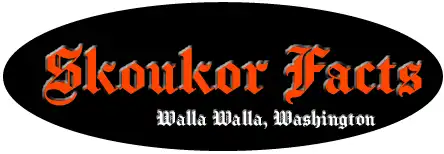

Comments